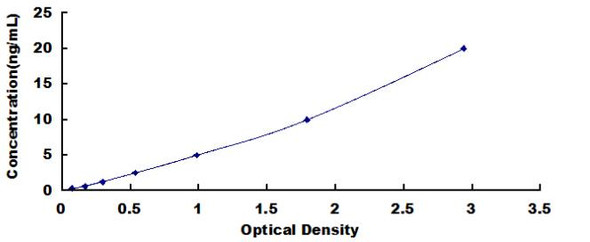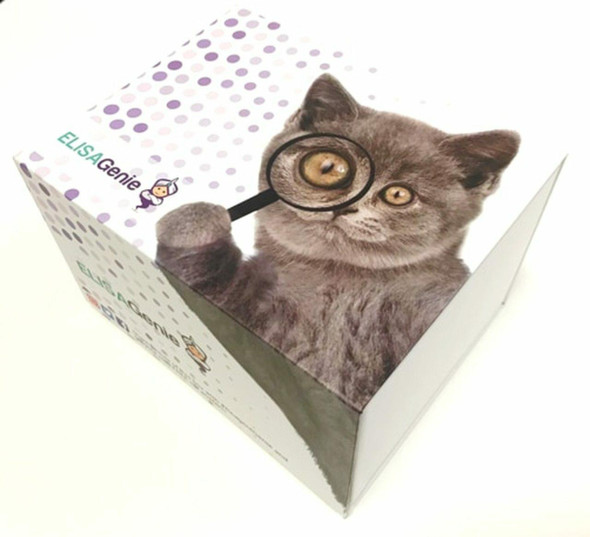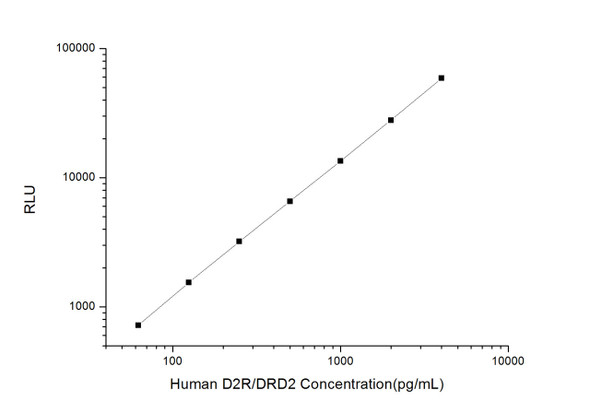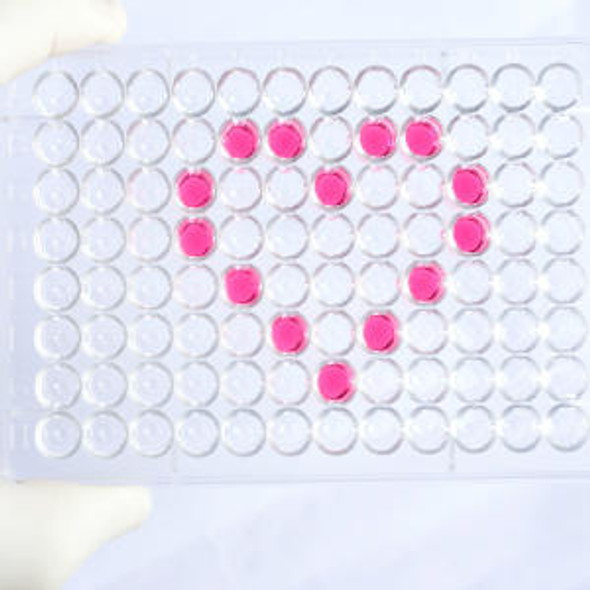Description
Human Dopamine D2 R / DRD2 ELISA
DRD2 (Dopamine Receptor D2) encodes the D2 subtype of the dopamine receptor. A missense mutation in DRD2 causes myoclonus dystonia; other mutations have been associated with schizophrenia. Diseases associated with DRD2 include Cocaine Dependence and Substance Dependence. Pathways associated with DRD2 include Development Dopamine D2 receptor transactivation of EGFR and Signaling by GPCR. The Assay Genie Human Dopamine D2 R / DRD2 ELISA is a highly sensitive assay for the quantitative measurement of Dopamine D2 R / DRD2 in serum, blood, plasma, cell culture supernatant and tissue samples.
| Product Name: | Human Dopamine D2 R / DRD2 ELISA Kit |
| Product Code: | HUFI02381 |
| Size: | 96 Assays |
| Alias: | D2R, DRD2, Dopamine Receptor D2 |
| Detection method: | Sandwich ELISA, Double Antibody |
| Application: | This immunoassay kit allows for the in vitro quantitative determination of Human D2R/DRD2 concentrations in serum plasma and other biological fluids. |
| Sensitivity: | 0.188ng/ml |
| Range: | 0.313-20ng/ml |
| Storage: | 4°C for 6 months |
| Note: | For Research Use Only |
| Recovery: | Matrices listed below were spiked with certain level of Human D2R/DRD2 and the recovery rates were calculated by comparing the measured value to the expected amount of Human D2R/DRD2 in samples. | ||||||||||||||||
| |||||||||||||||||
| Linearity: | The linearity of the kit was assayed by testing samples spiked with appropriate concentration of Human D2R/DRD2 and their serial dilutions. The results were demonstrated by the percentage of calculated concentration to the expected. | ||||||||||||||||
| |||||||||||||||||
| CV(%): | Intra-Assay: CV<8% Inter-Assay: CV<10% |
| Component | Quantity | Storage |
| ELISA Microplate (Dismountable) | 8×12 strips | 4°C for 6 months |
| Lyophilized Standard | 2 | 4°C/-20°C |
| Sample/Standard Dilution Buffer | 20ml | 4°C |
| Biotin-labeled Antibody(Concentrated) | 120ul | 4°C (Protect from light) |
| Antibody Dilution Buffer | 10ml | 4°C |
| HRP-Streptavidin Conjugate(SABC) | 120ul | 4°C (Protect from light) |
| SABC Dilution Buffer | 10ml | 4°C |
| TMB Substrate | 10ml | 4°C (Protect from light) |
| Stop Solution | 10ml | 4°C |
| Wash Buffer(25X) | 30ml | 4°C |
| Plate Sealer | 5 | - |
Other materials and equipment required:
- Microplate reader with 450 nm wavelength filter
- Multichannel Pipette, Pipette, microcentrifuge tubes and disposable pipette tips
- Incubator
- Deionized or distilled water
- Absorbent paper
- Buffer resevoir
| Uniprot | P14416 |
| UniProt Protein Function: | DRD2: Dopamine receptor whose activity is mediated by G proteins which inhibit adenylyl cyclase. Defects in DRD2 are associated with dystonia type 11 (DYT11); also known as alcohol-responsive dystonia. DYT11 is a myoclonic dystonia. Dystonia is defined by the presence of sustained involuntary muscle contractions, often leading to abnormal postures. DYT11 is characterized by involuntary lightning jerks and dystonic movements and postures alleviated by alcohol. Inheritance is autosomal dominant. The age of onset, pattern of body involvement, presence of myoclonus and response to alcohol are all variable. Belongs to the G-protein coupled receptor 1 family. 3 isoforms of the human protein are produced by alternative splicing. |
| UniProt Protein Details: | Protein type:Receptor, GPCR; GPCR, family 1; Membrane protein, multi-pass; Membrane protein, integral Chromosomal Location of Human Ortholog: 11q23 Cellular Component: axon; dendrite; integral to plasma membrane; nonmotile primary cilium; plasma membrane; synaptic vesicle membrane Molecular Function:adrenoceptor activity; dopamine binding; dopamine D2 receptor-like receptor activity; drug binding; identical protein binding; protein binding Biological Process: adenohypophysis development; adult walking behavior; arachidonic acid secretion; associative learning; axonogenesis; behavioral response to cocaine; behavioral response to ethanol; branching morphogenesis of a nerve; cerebral cortex GABAergic interneuron migration; circadian regulation of gene expression; dopamine metabolic process; dopamine receptor, adenylate cyclase inhibiting pathway; dopamine receptor, phospholipase C activating pathway; locomotory behavior; negative regulation of blood pressure; negative regulation of cell migration; negative regulation of cell proliferation; negative regulation of dopamine receptor signaling pathway; negative regulation of protein kinase B signaling cascade; negative regulation of protein secretion; negative regulation of synaptic transmission, glutamatergic; nerve-nerve synaptic transmission; peristalsis; phosphatidylinositol metabolic process; positive regulation of cytokinesis; positive regulation of dopamine uptake; positive regulation of growth hormone secretion; positive regulation of neuroblast proliferation; prepulse inhibition; protein localization; reduction of cytosolic calcium ion concentration; regulation of cAMP metabolic process; regulation of dopamine secretion; regulation of dopamine uptake; regulation of heart rate; regulation of long-term neuronal synaptic plasticity; regulation of potassium ion transport; regulation of sodium ion transport; regulation of synaptic transmission, GABAergic; regulation of systemic arterial blood pressure by neurological process; release of sequestered calcium ion into cytosol; response to amphetamine; response to cocaine; response to drug; response to light stimulus; response to morphine; response to toxin; sensory perception of smell; synaptic transmission, dopaminergic; synaptogenesis; thermoregulation; visual learning Disease: Myoclonic Dystonia |
| NCBI Summary: | This gene encodes the D2 subtype of the dopamine receptor. This G-protein coupled receptor inhibits adenylyl cyclase activity. A missense mutation in this gene causes myoclonus dystonia; other mutations have been associated with schizophrenia. Alternative splicing of this gene results in two transcript variants encoding different isoforms. A third variant has been described, but it has not been determined whether this form is normal or due to aberrant splicing. [provided by RefSeq, Jul 2008] |
| UniProt Code: | P14416 |
| NCBI GenInfo Identifier: | 118206 |
| NCBI Gene ID: | 1813 |
| NCBI Accession: | P14416.2 |
| UniProt Secondary Accession: | P14416,Q9NZR3, Q9UPA9, |
| UniProt Related Accession: | P14416 |
| Molecular Weight: | 50,847 Da |
| NCBI Full Name: | D(2) dopamine receptor |
| NCBI Synonym Full Names: | dopamine receptor D2 |
| NCBI Official Symbol: | DRD2 |
| NCBI Official Synonym Symbols: | D2R; D2DR |
| NCBI Protein Information: | D(2) dopamine receptor |
| UniProt Protein Name: | D(2) dopamine receptor |
| UniProt Synonym Protein Names: | Dopamine D2 receptor |
| Protein Family: | D(2) dopamine receptor |
| UniProt Gene Name: | DRD2 |
| UniProt Entry Name: | DRD2_HUMAN |
*Note: Protocols are specific to each batch/lot. For the correct instructions please follow the protocol included in your kit.
Before adding to wells, equilibrate the SABC working solution and TMB substrate for at least 30 min at 37°C. When diluting samples and reagents, they must be mixed completely and evenly. It is recommended to plot a standard curve for each test.
| Step | Protocol |
| 1. | Set standard, test sample and control (zero) wells on the pre-coated plate respectively, and then, record their positions. It is recommended to measure each standard and sample in duplicate. Wash plate 2 times before adding standard, sample and control (zero) wells! |
| 2. | Aliquot 0.1ml standard solutions into the standard wells. |
| 3. | Add 0.1 ml of Sample / Standard dilution buffer into the control (zero) well. |
| 4. | Add 0.1 ml of properly diluted sample ( Human serum, plasma, tissue homogenates and other biological fluids.) into test sample wells. |
| 5. | Seal the plate with a cover and incubate at 37 °C for 90 min. |
| 6. | Remove the cover and discard the plate content, clap the plate on the absorbent filter papers or other absorbent material. Do NOT let the wells completely dry at any time. Wash plate X2. |
| 7. | Add 0.1 ml of Biotin- detection antibody working solution into the above wells (standard, test sample & zero wells). Add the solution at the bottom of each well without touching the side wall. |
| 8. | Seal the plate with a cover and incubate at 37°C for 60 min. |
| 9. | Remove the cover, and wash plate 3 times with Wash buffer. Let wash buffer rest in wells for 1 min between each wash. |
| 10. | Add 0.1 ml of SABC working solution into each well, cover the plate and incubate at 37°C for 30 min. |
| 11. | Remove the cover and wash plate 5 times with Wash buffer, and each time let the wash buffer stay in the wells for 1-2 min. |
| 12. | Add 90 µl of TMB substrate into each well, cover the plate and incubate at 37°C in dark within 10-20 min. (Note: This incubation time is for reference use only, the optimal time should be determined by end user.) And the shades of blue can be seen in the first 3-4 wells (with most concentrated standard solutions), the other wells show no obvious color. |
| 13. | Add 50 µl of Stop solution into each well and mix thoroughly. The color changes into yellow immediately. |
| 14. | Read the O.D. absorbance at 450 nm in a microplate reader immediately after adding the stop solution. |
When carrying out an ELISA assay it is important to prepare your samples in order to achieve the best possible results. Below we have a list of procedures for the preparation of samples for different sample types.
| Sample Type | Protocol |
| Serum | If using serum separator tubes, allow samples to clot for 30 minutes at room temperature. Centrifuge for 10 minutes at 1,000x g. Collect the serum fraction and assay promptly or aliquot and store the samples at -80°C. Avoid multiple freeze-thaw cycles. If serum separator tubes are not being used, allow samples to clot overnight at 2-8°C. Centrifuge for 10 minutes at 1,000x g. Remove serum and assay promptly or aliquot and store the samples at -80°C. Avoid multiple freeze-thaw cycles. |
| Plasma | Collect plasma using EDTA or heparin as an anticoagulant. Centrifuge samples at 4°C for 15 mins at 1000 × g within 30 mins of collection. Collect the plasma fraction and assay promptly or aliquot and store the samples at -80°C. Avoid multiple freeze-thaw cycles. Note: Over haemolysed samples are not suitable for use with this kit. |
| Urine & Cerebrospinal Fluid | Collect the urine (mid-stream) in a sterile container, centrifuge for 20 mins at 2000-3000 rpm. Remove supernatant and assay immediately. If any precipitation is detected, repeat the centrifugation step. A similar protocol can be used for cerebrospinal fluid. |
| Cell culture supernatant | Collect the cell culture media by pipette, followed by centrifugation at 4°C for 20 mins at 1500 rpm. Collect the clear supernatant and assay immediately. |
| Cell lysates | Solubilize cells in lysis buffer and allow to sit on ice for 30 minutes. Centrifuge tubes at 14,000 x g for 5 minutes to remove insoluble material. Aliquot the supernatant into a new tube and discard the remaining whole cell extract. Quantify total protein concentration using a total protein assay. Assay immediately or aliquot and store at ≤ -20 °C. |
| Tissue homogenates | The preparation of tissue homogenates will vary depending upon tissue type. Rinse tissue with 1X PBS to remove excess blood & homogenize in 20ml of 1X PBS (including protease inhibitors) and store overnight at ≤ -20°C. Two freeze-thaw cycles are required to break the cell membranes. To further disrupt the cell membranes you can sonicate the samples. Centrifuge homogenates for 5 mins at 5000xg. Remove the supernatant and assay immediately or aliquot and store at -20°C or -80°C. |
| Tissue lysates | Rinse tissue with PBS, cut into 1-2 mm pieces, and homogenize with a tissue homogenizer in PBS. Add an equal volume of RIPA buffer containing protease inhibitors and lyse tissues at room temperature for 30 minutes with gentle agitation. Centrifuge to remove debris. Quantify total protein concentration using a total protein assay. Assay immediately or aliquot and store at ≤ -20 °C. |
| Breast Milk | Collect milk samples and centrifuge at 10,000 x g for 60 min at 4°C. Aliquot the supernatant and assay. For long term use, store samples at -80°C. Minimize freeze/thaw cycles. |
Fill out our quote form below and a dedicated member of staff will get back to you within one working day!






